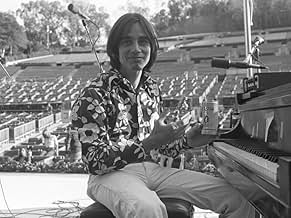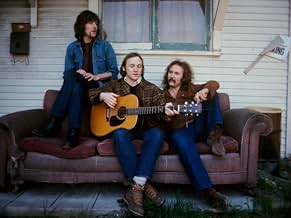ÉVALUATION IMDb
8,2/10
1,4 k
MA NOTE
Documentaire sur un monde mythique offrant un regard de près sur la vie des musiciens qui ont habité Laurel Canyon. Il dresse un portrait intime des artistes qui ont créé une révolution musi... Tout lireDocumentaire sur un monde mythique offrant un regard de près sur la vie des musiciens qui ont habité Laurel Canyon. Il dresse un portrait intime des artistes qui ont créé une révolution musicale qui allait changer la culture populaire.Documentaire sur un monde mythique offrant un regard de près sur la vie des musiciens qui ont habité Laurel Canyon. Il dresse un portrait intime des artistes qui ont créé une révolution musicale qui allait changer la culture populaire.
- Nommé pour 3 prix Primetime Emmy
- 2 victoires et 7 nominations au total
Parcourir les épisodes
Avis en vedette
10dvh27
Amazing doc, loved the way it flowed, loved the way the narration was done with audio as opposed to having someone In the interview chair which definitely made it more romantic in my opinion. Yes a lot we have heard before but we have never heard it before in such a wonderfully mystical way. Loved it.
"It was just about a time, the creative awakening." ~ Jackson Browne
Allison Ellwood directed this two-part docuseries that covers the time and place where many of the top musicians of the day lived and hung out in a magical, semi-communal style life in the hills of California's Laurel Canyon in the heyday of the 1960s and early 1970s. As a child, I was transplanted from the midwest to the base of this fertile canyon and into this creative aura that permeated my soul.
The film moves fast, but not too fast, in a sumptuous display of picture and video images that tumble forward in accompaniment to the tunes and tales of beloved Troubadours.
Photographers Henry Diltz and Nurit Wilde, whose photographic contributions are seminal to documenting this tremendous time, both explain how they began taking pictures of the talented, photogenic folks on the cutting edge of the music and social scene to capture the moments they were part of. Over time, their photographic passions unfolded into stunning historical archives of this special time in the canyon and the reach these musicans had on the world.
This pleasureful project wove together individual stories I'd heard over the years with bits and bobs that were new to me. No matter how much you already know or not, this film offers a satisfying overview of the scene: David Crosby produced Joni Mitchell's first album in Florida and brought her to California where they landed in the rural canyon that runs as an artery through urban Los Angeles. Many of the artists-in-residence were hosted by, (and introduced to each other via), the exquisite, magnanimous "Mama" Cass Elliot of The Mamas & The Papas.
Crosby, Still, and Nash, and ultimately Young, hook up and go through various ups-and-down stages of their musical partnership. Linda Ronstadt and JD Souther have a cute meet and move in together, leading to love and creative collaboration; those in the orbit of luminous song stylist extraordinare, Linda, found themselves incarnating as a supergroup, The Eagles.
Graham Nash narrates his sweet story of how he and Joni Mitchell, then deep in domestic bliss, ate at Art's Deli on Ventura Blvd. one morning, after which Joni bought a vase she fancied, they returned to their canyon home, Joni went home to pick flowers to fill her new pretty purchase, and while she was out, her piano was empty and Graham presided over it and out spilled "Our House."
There is precious video of Eric Clapton listening gape mouthed to a fresh Joni play her unique guitar chords at a house party; Nurit Wilde adored taking photos of the affable Peter Tork, who had a penchant for nudity, and hosted pool parties at his haven in the hills; and one of my favorite moments is when Jackson Browne, the new kid, (then a georgous, cherub-faced young man), played "Song for Adam," for an impressed David Crosby, who dubbed Jackson part of the new wave of canyon musicians.
Apolitical young singer-songwriters found their voice during this transformative time. A seminal moment occured for Stephen Stills in 1966 when he witnessed the Sunset Strip curfew riots with violent clashes between police and the youth; he went home and wrote, "For What It's Worth."
In 1969, the moon landing was followed and juxtiposed by the Manson Murders; one positively electrifying event so far away, yet glowed larger than life in every living room in the country, and the other, awful events, so close by and negatively charged that they cast a gorey gloom over the graceful goodness of the days.
Groups and singers that brought country music into the rock fold were covered, as was The Monterey Pop Festival, and the move from playng intimate clubs like the Troubadour (where the artists could meet up, collaborate, and soak in each other's songs) to being booked at huge arenas, where larger audiences could enjoy the shows, but the cozy creativity of the Laurel Canyonites was lost.
The list of talent in the canyon included: Joni Mitchell; Crosby, Still, Nash & Young; Buffalo Springfield; The Byrds; The Mamas & The Papas; The Doors; Alice Cooper;The Monkees; Love; The Turtles; Jackson Browne; Linda Ronstadt; Little Feat; and The Flying Burrito Brothers. Steve Martin too!
I highly recommend this movie.
Allison Ellwood directed this two-part docuseries that covers the time and place where many of the top musicians of the day lived and hung out in a magical, semi-communal style life in the hills of California's Laurel Canyon in the heyday of the 1960s and early 1970s. As a child, I was transplanted from the midwest to the base of this fertile canyon and into this creative aura that permeated my soul.
The film moves fast, but not too fast, in a sumptuous display of picture and video images that tumble forward in accompaniment to the tunes and tales of beloved Troubadours.
Photographers Henry Diltz and Nurit Wilde, whose photographic contributions are seminal to documenting this tremendous time, both explain how they began taking pictures of the talented, photogenic folks on the cutting edge of the music and social scene to capture the moments they were part of. Over time, their photographic passions unfolded into stunning historical archives of this special time in the canyon and the reach these musicans had on the world.
This pleasureful project wove together individual stories I'd heard over the years with bits and bobs that were new to me. No matter how much you already know or not, this film offers a satisfying overview of the scene: David Crosby produced Joni Mitchell's first album in Florida and brought her to California where they landed in the rural canyon that runs as an artery through urban Los Angeles. Many of the artists-in-residence were hosted by, (and introduced to each other via), the exquisite, magnanimous "Mama" Cass Elliot of The Mamas & The Papas.
Crosby, Still, and Nash, and ultimately Young, hook up and go through various ups-and-down stages of their musical partnership. Linda Ronstadt and JD Souther have a cute meet and move in together, leading to love and creative collaboration; those in the orbit of luminous song stylist extraordinare, Linda, found themselves incarnating as a supergroup, The Eagles.
Graham Nash narrates his sweet story of how he and Joni Mitchell, then deep in domestic bliss, ate at Art's Deli on Ventura Blvd. one morning, after which Joni bought a vase she fancied, they returned to their canyon home, Joni went home to pick flowers to fill her new pretty purchase, and while she was out, her piano was empty and Graham presided over it and out spilled "Our House."
There is precious video of Eric Clapton listening gape mouthed to a fresh Joni play her unique guitar chords at a house party; Nurit Wilde adored taking photos of the affable Peter Tork, who had a penchant for nudity, and hosted pool parties at his haven in the hills; and one of my favorite moments is when Jackson Browne, the new kid, (then a georgous, cherub-faced young man), played "Song for Adam," for an impressed David Crosby, who dubbed Jackson part of the new wave of canyon musicians.
Apolitical young singer-songwriters found their voice during this transformative time. A seminal moment occured for Stephen Stills in 1966 when he witnessed the Sunset Strip curfew riots with violent clashes between police and the youth; he went home and wrote, "For What It's Worth."
In 1969, the moon landing was followed and juxtiposed by the Manson Murders; one positively electrifying event so far away, yet glowed larger than life in every living room in the country, and the other, awful events, so close by and negatively charged that they cast a gorey gloom over the graceful goodness of the days.
Groups and singers that brought country music into the rock fold were covered, as was The Monterey Pop Festival, and the move from playng intimate clubs like the Troubadour (where the artists could meet up, collaborate, and soak in each other's songs) to being booked at huge arenas, where larger audiences could enjoy the shows, but the cozy creativity of the Laurel Canyonites was lost.
The list of talent in the canyon included: Joni Mitchell; Crosby, Still, Nash & Young; Buffalo Springfield; The Byrds; The Mamas & The Papas; The Doors; Alice Cooper;The Monkees; Love; The Turtles; Jackson Browne; Linda Ronstadt; Little Feat; and The Flying Burrito Brothers. Steve Martin too!
I highly recommend this movie.
I was very pleasantly surprised at the the amount of original footage and narration by the singers and songwriters themselves, thinking that there could not possibly be anything left that had not been shown elsewhere before. The show does a very creative job of joining that particular place - Laurel Canyon Road - with stories about the people and music that came out of that one location. Not to be missed if you love the music of that period in time. Thank you for a wonderful evening.
With a majority of today's pop\rock music either created inside a game show, or lost in streaming obscurity Laural Canyon shines a light on what could be possible again. Obviously the record business is not the same, and the modality of sharing new music has radically changed. However, LC teaches us the music that changed us came from a group of people who were first and foremost community minded. The concept of a ' music scene' cannot be lost on the viewer. What that music offers the listener, the enthusiast is an energy. It seems to me it's difficult if not impossible for a lasting music scene filled with energy and life to exist inside one's and zero's alone. If you love music and want to share how it was created out of thin air (and how it could happen again), show this to your teenager. Before it fades away into the dust of 'old stuff'.
If you're a fan of music from the mid 60's to the early 70's this 2 part documentary is a fantastic insight from people who witnessed how a small community of hopeful musicians became world renowned from the first wave of The Byrds finding success by Bob Dylan's backing vocals singing out of tune to the second wave and the likes of the Eagles dominating the radio airwaves across the world.
I really wish this time capsule could of been made longer but as a fan seeing and hearing how the connection's between young hopefuls spark into some of the greatest music ever written and recorded.
A truly magical time shown it great detail , which leaves you thinking just how much the world could do with a repeat of the 'Laurel Canyon' vibe springing up some in today's music machine
Making music for musics sake not just to make money for the suits in an office
Le saviez-vous
- ConnexionsFeatured in The 2020 Primetime Creative Arts Emmy Awards (2020)
Meilleurs choix
Connectez-vous pour évaluer et surveiller les recommandations personnalisées
- How many seasons does Laurel Canyon have?Propulsé par Alexa
- I missed Laurel Canyon, Part 1 on May 31. How can I watch it?
Détails
- Date de sortie
- Pays d’origine
- Site officiel
- Langue
- Aussi connu sous le nom de
- Laurel Canyon: A Place in Time
- Lieux de tournage
- sociétés de production
- Consultez plus de crédits d'entreprise sur IMDbPro
- Durée1 heure 18 minutes
- Couleur
- Mixage
- Rapport de forme
- 1.78 : 1
Contribuer à cette page
Suggérer une modification ou ajouter du contenu manquant

Lacune principale
By what name was Laurel Canyon (2020) officially released in India in English?
Répondre


































